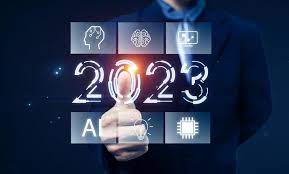One of my favorite things to do when the new year is starting is to roam around looking at what the tech prognosticators are prognosticating for the coming year. There’s no end to the prediction articles that are out there, but I managed to narrow things down. Mostly, I settled on reading those that approached technology trends from the business perspective, i.e., what business leaders need to be on the lookout for. I find this perspective plenty interesting, as this is the arena where what we all work on has its impact (and, at the same time, it’s ultimately business that impacts the direction that we all go in).
The “business perspectives on tech trends” articles I saw pretty much all landed in the same place when they looked ahead at 2023, starting with AI on through the metaverse, robotics, and sustainability. The one I found best expressed the general sense of what the next year holds was Bernard Marr’s predictions from Forbes.
This isn’t the first time that someone’s predicting ubiquitous AI. I bet if I went back a few years, I’d find it on plenty of prediction lists. In Marr’s view, 2023 is the year during which AI “will become real,” with businesses deploying it in more and more of its products and services. He focused specifically on retail, where AI is used everywhere from making recommendations to consumers and managing complex inventory systems.
Marr also sees the metaverse (“a more immersive internet”) becoming more real, with AR and VR advancements, including avatar technology, that aren’t just for gamers, but will be used in platforms that businesses will use for richer meeting, training, onboarding, and collaboration environments. (Note to self: pick a great avatar.)
Forget the wilder things happening out there in crypto world. Blockchain/Web3 technology has the potential to make data more secure. Marr also sees NFTs “become more usable and practical,” e.g., an NFT concert ticket providing virtual backstage access.
With digital twin technology and 3D printing, the digital and physical worlds will be bridged. “Digital twins are virtual simulations of real-world processes, operations, or products,” a lab for safely and cost-effectively testing new product ideas. Once tested, products can be produced in the real world via 3D printing.
Nature will be increasingly editable. New materials, created using nanotechnology, will have features like “water resistance and self-healing capabilities.” Gene editing (CRISPR-Cas9) will accelerate, enabling scientists “to correct DNA mutations, solve the problem of food allergies, increase the health of crops, or even edit human characteristics like eye and hair color.” I don’t know how useful that latter use case is, but if they can edit hair onto a bald head, well, now we’re talking.
Just as we’ve been talking AI for years, so, too with quantum computing. In Marr’s view, the race is on “to develop quantum computing at scale,” bringing with it the potential for “computers capable of operating a trillion times more quickly than the fastest traditional processors available today.” A trillion times? Pretty unfathomable. The downside? The encryption methods in use today will be useless.
When it comes to green technology, look for progress to be made. Green hydrogen. A green pipeline from North Sea wind plants. Decentralization of the power grids. Marr sees these all happening, helping decrease carbon emissions.
Add more human-like robots to the list of technologies (AI, quantum computing) that have been on trend lists for quite a while. We’re getting used to the notion of robots in warehouses and factories. How about as “event greeters, bartenders, concierges, and companions for older adults.” O, brave new world!
And let’s not forget about autonomous systems. Maybe the self-driving cars haven’t happened as rapidly as some had predicted, but factories and warehouses are becoming increasingly autonomous. (AI + robots = autonomous technology, and the robots don’t have to look anywhere near as human as a bartender.)
Sustainable technology is also on Marr’s drawing board for 2023. Most of us rely on technology throughout our personal and professional lives, generally without thinking about “where rare earth components for things like computer chips originate and how we’re consuming them,” or worrying about the energy-hogging data centers used by cloud services (Netflix, Spotify). Marr believes that in 2023, consumers will become more conscious of the need for more sustainable technology, and begin pushing businesses to do more about it.
I didn’t want to completely ignore the tech perspective on tech trends, so I’ll include a couple of observations from Brian Dipert’s 2023 forecasts from EDN.
On the semiconductor supply front, Dipert notes that while things are greatly improved over where they stood last year at this time, he foresees inconsistency. When it comes to high volume, commodity semiconductors, he sees oversupply.
Specifically, I’m talking about semiconductor memory, both volatile (DRAM) and nonvolatile (NAND flash memory). Prices are crashing, along with profits, translating into customer delight and supplier angst.
On the other hand, when it comes to semiconductors that are less commodified and produced at lower volumes, Dipert believes that any full restoration of supply stability will be more gradual, and with hiccups like last year’s “automobile manufacturing lines shut down due to IC non-availability.”
A couple of things likely to improve the supply situation: the faltering crypto market means less compute-intensive bitcoin mining, freeing up demand. And the CHIPS and Science Act, while it won’t have an impact in 2023, will in the longer run help with domestic supply.
Like those on the business side expressing concerns over sustainability, Dipert sees that environmental issues will come more to the fore in 2023. He notes that chip manufacture is highly demanding when it comes to consumption of water and electricity. Progress toward achieving more use of green energy sources is likely to remain slow, but awareness of the issues should eventually translate into more action.
Personally, I don’t make predictions, other than to predict that 2023 will bring with it plenty of interesting and technically challenging work for the engineers at Critical Link.
